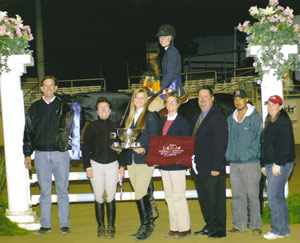By Erna L. Adelson
 The Search for the Best is Back
The Search for the Best is Back
As the qualification period for the USEF Talent Search gets underway, rankings reveal the top of the nation’s leading equitation contenders. Each day spent training, preparing and competing will culminate, for some, in a mark on the storied history of the sport. Equitation has certainly evolved over the years, from the days of Jackie Kennedy Onassis to last year’s Sophie Benjamin and Hannah Selleck, though competitors remain true to the heart of the sport—the bond between horse and rider. It is this special bond that defines the membership of the United States Equestrian Federation (USEF). Since 1917, the Federation has been dedicated to pursuing excellence, promoting growth and providing a safe and level playing field for both its equine and human athletes. In this tradition, the 2009 USEF Talent Search will, of course, reveal the potential bearers of the crimson coat in international competition, but it will also indicate something more, something innate that materializes with the chemistry unique to horses and riders.
The OG of the Big Eq
Before the name George Morris was synonymous with horsemanship, the second president of the Association of American Horse Shows, Mr. Alfred Maclay, was the authority on the rules and regulations used to license members and venues. In 1927, these policies filled a six-page pamphlet. Though now they are much more extensive, the original sentiment is still referred to upon evaluation of candidates today—and Maclay’s legacy as a horseman lives on in the medal final that bears his name.
Much of the terminology surrounding the Talent Search stems from the days of Maclay’s tenure. The nickname for equitation classes as ‘Medal Classes’ has stuck almost 80 years since riders were first awarded medals for their achievement in winning an equitation class. The newer nomenclature, the “big eqs” refers to the classes in which riders show to qualify for several national championships, especially the historic and coveted USEF Talent Search, USEF Medal and ASPCA Maclay Championships.
The Star Search is Born
The USEF has several fundamental responsibilities as the governing body of US equestrian sport: The USEF trains, selects, and funds our United States Equestrian Team, licenses equestrian competitions of all levels across the United States each year, and encourages growth among newcomers as well as the coming generation. The Talent Search was started in 1956 by the U.S. Equestrian Team (now the USET Foundation) as a USET Medal Program in order to fulfill the cultivation aspect of their duties. In 1982, the Medal Program incorporated year-end finals as a further goal. In 1994, the USET decided to combine the USET Medal Program with the USET Show Jumping Talent Search Program. This name change better reflected the focus of the program by asking developing riders to meet a more difficult set of standards than required in other competitions, thus helping to prepare them for berths on future international show jumping squads.
The Show Jumping Talent Search Program became part of the USEF’s Show Jumping High Performance Program in 2005. The Platinum Performance / USEF Show Jumping Talent Search Finals attracts the nation’s top Juniors and Young Riders in head-to-head competition. The Finals are open to U.S. citizens 21 years old and younger who have qualified through their placement in Platinum Performance / USEF Show Jumping Talent Search Classes and include a matrix of phases to test entrants’ skills in the show jumping arena, including equitation, speed over difficult courses and gymnastics, derby-style terrain, and a ride-off.
Graduates of the program include some of the top competitors and trainers on the circuit today, each doing their part to inspire and train the next generation of equestrians.
In this week’s final 37 riders will vie for the title. Last year’s West Coast winner, Hannah Selleck, just returned from the Spruce Masters where she competed against the best and brought home prizes. On the East Coast qualified riders will compete on the weekend of October 4th-5th in Gladstone, NJ. Now a sophomore at Princeton, California-based Sophie Benjamin won the coveted East Coast Finals in 2008.
